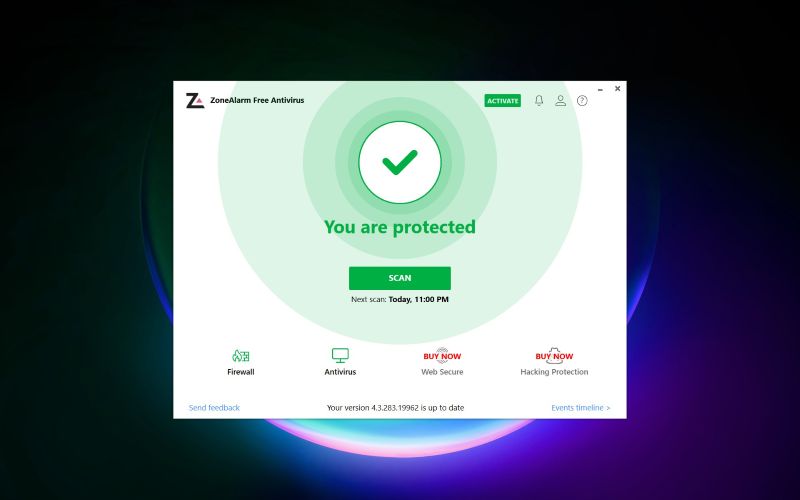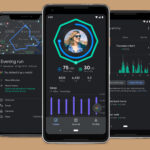Why you can trust TechRadar
We spend hours testing every product or service we review, so you can be sure you’re buying the best. Find out more about how we test.
ZoneAlarm is one of the cybersecurity pioneers, offering its firewall protection not just to businesses but also to consumers back in the 1990s, when consumer firewall wasn’t really a thing. What’s more, it instituted the concept of hardening a device’s firewall against direct attacks, today featuring an inbound intrusion detection system and the ability to control outbound connections by apps.
In 2004, ZoneAlarm, which was developed by Zone Labs, was acquired by Check Point Software Technologies, a major software and combined hardware provider for network, endpoint, mobile, cloud, and data security, as well as security management.
Over the years, ZoneAlarm has changed and adapted its offering (as well as its interface) to be more in line with the times. Nowadays, ZoneAlarm offers three main tiers of its antivirus product, courtesy of Check Point’s powerful cybersecurity platform.
These include ZoneAlarm Free Antivirus, ZoneAlarm Pro Antivirus + Firewall, and ZoneAlarm Extreme Security NextGen, all of which offer different levels of protection and features. The company offers other standalone products, such as ZoneAlarm Anti-Ransomware.
As it happens, the free version comes equipped with the usual antivirus and anti-spyware function, an advanced firewall (monitoring apps, stopping new and so far unknown attacks), and a two-way firewall (making your PC invisible to hackers) application control, anti-bot, and 24/7 online support – for one PC.
That said, real-time cloud security, anti-phishing, threat extraction, safe browsing, and threat emulation for up to five PCs is reserved for the paid upper tier, Pro Antivirus + Firewall, whereas the top-of-the-line Extreme Security NextGen throws in content filtering, anti-keylogger, anti-ransomware, and mobile security, while supporting up to 50 PCs at the same time.
The ZoneAlarm Pro for one device costs $24.95 for the first year, renewing at $39.95. If you need coverage for three PCs, you can get it at $32.95 per year initially, renewing at $49.95. A five-device service starts at $35.95, renewing at $54.95, 10 devices are covered by a $64.95 payment renewing at $99.95, while the coverage for as many as 50 PCs would cost you just $259.95 for the year one, renewing at $259.95. Do note that Pro Antivirus only supports Windows PC devices, making it a bit of a limited option.
Meanwhile, ZoneAlarm Extreme Security NextGen charges $34.95 for one device during the initial year, increasing it to $59.95 for each subsequent 12-month period of use. For three devices, it charges $42.95 (renewing at $64.95), five devices would cost you $44.95 for the first year ($69.95 for each subsequent year), while 10 devices would set you back by $89.95 during the first year (renewing at $139.95).
You may also get coverage for 25 devices, with this plan at $189.95 initially, after which you’ll pay $289.95 per year, while coverage for 50 devices comes with a price tag of $357.95 for the first year, renewing at $549.95. Extreme Security supports Windows, Android, and iOS devices.
It is also important to note that both carry certain discounts if you take a 2-year subscription. For instance, protecting five devices for the duration of two years will cost you only $61.95 for the first year, which would otherwise cost you $90.90 if you took it on a year-by-year basis. In other words, you’re getting an impressive 68.17% discount.
For the Extreme Security package, the discounts are very similar. In this case, a 2-year subscription package covering five devices goes for $72.95, which is a 63.51% reduction compared to the $114.9 you would pay if you signed up for the package to renew each year.
Finally, both Pro and Extreme Security NextGen have a 30-day free trial and a 30-day money-back guarantee, giving you enough time to test the service out before making the final decision.
However, the free trial doesn’t give all that much and actually doesn’t differ in any way from the free tier, considering you need to activate it to access more than just its firewall and antivirus features. A pity, as someone might be attracted to actually buying the platform if they had the opportunity to check it out in more depth for free.
Setup
Downloading ZoneAlarm Free takes an unusual amount of time. At first, the downloader told us we would have to wait for two hours, changing the time to anywhere between 20 minutes and 20 hours, making our system very sluggish while it was doing this.
As it turns out, we waited for about 30 minutes, which is a lot longer than any other antivirus we had installed before. Still, installing the platform went a lot faster than this (although not nearly as fast compared to the competition).
Features
ZoneAlarm has gotten its name thanks to its method of controlling program access – by dividing all network connections into so-called ‘zones.’ Hence there are several such zones in ZoneAlarm’s vocabulary: the ‘trusted zone’ which typically includes the user’s local area network and can share resources like files and printers.
Then, there’s the ‘public zone’ that includes everything outside the trusted zone, and in which the user can grant permissions to apps before they try connecting to the Internet (such as before the initial launch) or ZoneAlarm will ask the user to grant these permissions.
Finally, the ‘blocked zone’ is where all the devices, networks, and/or apps that you decided you don’t trust with making traffic to or from end up. The firewall is on by default as soon as you install your ZoneAlarm software, and you don’t need to do anything unless you really want to change the default configuration or temporarily turn off the firewall for any reason.
Having said that, ZoneAlarm’s firewall currently allows access to every program by default, without letting you know when it finds something suspicious. If you want to modify an app’s permissions, you’ll have to go manually digging for it in the Application Control and change the settings yourself for each of the programs.
Open your ZoneAlarm app, and you’ll see a sleek green-white window that provides you with your protection status, a ‘Scan’ button, the time and date of the next automatic scan, as well as four icons – Firewall, Antivirus, Web Secure, and Hacking Protection.
The Firewall itself opens a set of features, including managing the rules for your ‘zones’ or networks (public or trusted), setting up the public and trusted zone sensitivity, as well as observing the previous firewall events, with a button to add a new entry (IP address, IP range, or subnet) as a zone rule. Its above-mentioned ‘Application Permissions’ section lists all the apps on your device and allows you to set the default action to ‘Allow Connection,’ ‘Block Connection,’ or ‘Terminate Process.’ Finally, you can turn on/off the anti-bot service.
Next is the Antivirus section, where you can view the quarantine, add exceptions, start a full scan, scan a particular folder, or schedule a critical (quick scan to identify threats) or full scan (deep scan of the entire system), on a daily, weekly, or monthly basis.
The Web Secure dashboard features Anti-Phishing, Safe Downloads, and Content Filtering options, whereas the Hacking Protection area contains Anti-Ransomware, Advanced File Protection, and Anti-Keylogger capabilities (none of which is accessible with the free version).
Previously, the ZoneAlarm Free Antivirus offered an entire year of simple identity protection by its partner Identity Guard, with a feature known as Identity Lock to prevent anyone from stealing your sensitive personal data from your device. However, these now seem to be gone.
On top of that, it seems to have also dropped the free Chrome extension, which was a phishing-oriented version of its Web Secure for free users to protect their credentials against phishing attempts and malicious document downloads.
Protection
Once ZoneAlarm is up and running, its protection begins, automatically updating the virus definitions and running occasional scans, which you’ll only find out from the notifications triggered by these events. Starting a full scan takes about 50 minutes, which is a bit long, but we’ve seen longer.
That said, it doesn’t get any faster with the subsequent scans, which also took about 52 minutes. This means that ZoneAlarm doesn’t use its first full scan to optimize for future procedures, as opposed to some of its competitors.
Upon testing with a recommended malware testing file, ZoneAlarm sprang into action immediately, recognizing the threat and moving it to the quarantine, letting us know what happened with a full-sized popup message that doesn’t go away until you dismiss it. You can reveal further details about the file and click again to access the list of all quarantined files.
The Web Secure mechanism is nothing to write home about, only working in Chrome, and not at all successful against malware-hosting websites – blocking only phishing sites. In other words, ZoneAlarm has no efficient ways to protect us from accessing a dangerous site, something that even the built-in Microsoft Defender can do without much effort.
Meanwhile, the personal firewall that comes equipped with even the free version might be a bit unnecessary, but it’s a nice addition considering it doesn’t cost a thing. ZoneAlarm also has its firewall available as a standalone, free product.
SE Labs hasn’t tested ZoneAlarm since Q4 2019, when it scored 85% in total accuracy rating, 87% in protection rating, 100% in legitimate accuracy rating (how well it tuned its detection engine to classify legitimate applications and URLs), a protection score of 97 points, and receiving a high AAA award.
Similarly, AV-Test did its last test of ZoneAlarm in December 2019, when it tested the paid Pro Antivirus + Firewall product, giving it a 6/6 for protection, a 6/6 for usability, and 4.5/6 for performance, as it underperformed in area of installing frequently used applications.
The same testing firm also analyzed the business version of ZoneAlarm, called Check Point, which lends its virus-defending platform to consumer products, for the period of July – August 2024, awarding it a 6/6 in all three observed areas – protection, performance, and usability, albeit also noting a slightly poorer performance in terms of installation of frequently-used applications.
A bit more recently, MRG-Effitas analyzed ZoneAlarm Mobile Security in Q2 2023, observing 82.30% accuracy in overall non-PUA (‘potentially unwanted applications’) detection, 100% accuracy in PUA detection, 86.76% in detecting trojans, 81.13% in accurately identifying spyware, but missing 100% simulator samples.
Meanwhile, the most recent test comes from AV-Comparatives, which tested ZoneAlarm Extreme Security NextGen as a non-dedicated fake-shop detecting solution in its Q4 2024 Fake Shops Detection Test, in which its detection rates in November were between 21% and 30%, with no false positives.
Final verdict
ZoneAlarm used to have a stellar reputation as the security industry’s pioneer looking out for the consumer back when no one really cared and business data safety was the primary concern. However, it has since degraded and today lags behind its competitors, many of which have much more advanced, faster, and richer platforms in terms of their antivirus and anti-malware capabilities, speed and performance, built-in features, extras, and configuration options. This is perhaps best illustrated by the lack of interest demonstrated by the leading antivirus testing labs, which haven’t been actively reporting on ZoneAlarm’s performance for years. Other than that, it’s a solid firewall solution for the price and ease of use.
Read the full article here













